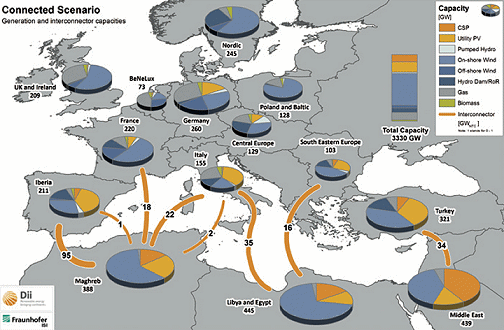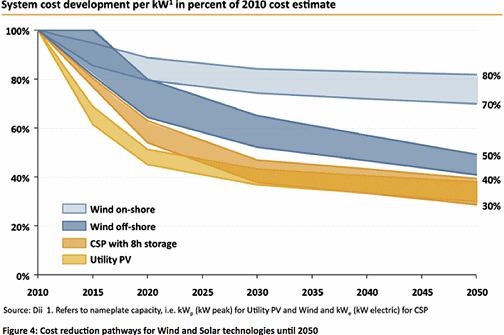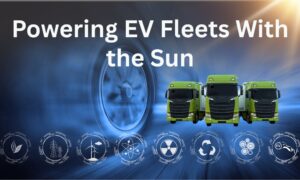Of all the most ambitious renewable energy projects around the world, the European Desertec Industrial Initiative ranks right at the top- some would say fantastic in both the true and the modern sense of the word.
The basic plan of Desertec is to harness the wind and solar power from north Africa and the Middle East and use it- along with similar resources from southern Europe- to help Europe cut 95 per cent of its emissions from its electricity grid by 2050, and to have renewables provide 90 per cent of its power needs.
A new report released by the initiative- which is a consortium of 21 industrial giants such as Siemens, E.ON, Deutsche Bank, Morgan Stanley, Enel, and Shell- says this can be done, at the same time as reducing electricity costs and making the grid more stable than it would otherwise be.
The 2050 Desert Power report released late last week, co-authored by the Fraunhofer Institute, says that by importing 20 per cent of its energy needs from the Middle East and north Africa (MENA), Europe can save €33 billion a year, or €30 for each megawatt hour of imported electricity.
It also concludes that MENA could generate €63 billion in annual energy exports and meet its own energy requirements reliably from solar and wind, as well as cut its emissions by 50 per cent, even despite massive increase in demand expected from the anticipated 45 per cent growth in population over the coming decades.
As well, the combined area, a new geographic entity dubbed “Eumena” for energy purposes- would benefit from a 40 per cent drop in the marginal cost of Co2 reductions as it meets its 95 per cent reduction target. Clearly, if this can be done- and the report says on the issue of costs and technology it is very achievable, even if it is more challenging on the political front- then it is an attractive proposition for both regions.
“An interconnected, renewables-based power system for EUMENA is valuable for reasons of competitiveness, sustainability and security of supply,” the report concludes, although it notes: “This requires a paradigm shift from today’s weakly interconnected, fossil fuel-based system to an integrated, sustainable one.”
It paints a scenario where 91 per cent of Eumena’s power needs comes from renewables- with just 9 per cent from gas-fired generation by 2050. Wind accounts for 53 per cent (48 per cent onshore, 5 per cent offshore), solar accounts for 25 per cent (with solar thermal providing 16 per cent and solar PV 9 per cent), while other renewables such as hydro power, geothermal, and biomass provide the rest.
Interestingly, it predicts countries such as Saudi Arabia, Turkey and Egypt will consume as much electricity as France, Germany the UK and Italy, so most of the desert power will be consumed locally. The biggest exporters- the southern powerhouses – will be Algeria, Morocco, Tunisia and Libya, while the northern powerhouses will be Scandinavia (particularly Norway with huge hydro resources and small population). The two sources will intersect over eight different transmission routes.

The project estimates that each European still provides at least 70 per cent of its power needs. But by having an EUMENA-wide grid, fewer gas peaking plants are needed, and reliability is enhanced. Half of the €30/MWh saving comes from the fact that renewables are cheaper to produce in Mena than in Europe- the other half from a lower reliance on fossil fuel peakers, and there is less redundant capacity. (Indeed, this accords with conclusions made by David Mills and the UNSW team on their 100 per cent scenarios).
The report says that the power sources are based on proven and reliable technology. The only aspect missing at the moment is cost competitiveness across the board. But it says that by 2050, wind and solar should be producing at around €50/MWh. It uses this graph below to suggest the cost reductions that can be anticipated over the coming decades. The two solar technologies- PV and CSP (solar thermal)- lead the way, with onshore wind delivering the lowest reduction.

The key to the project is the creation of a vast electric ring around Europe that properly connects all countries. Some countries rich in renewables are currently unable to use all their capacity- Ireland being one of them. However, separately to the Desertec initiative. Irish business Eddie O’Connor, the CEO of Mainstream Renewables, has unveiled a plan to invest €12.5 billion to expand the country’s wind energy farms, and build links to supply the UK, which is looking as if it will fall dramatically short of its own clean energy targets.
O’Connor describes the plan as the biggest infrastructure development in Ireland since the country was electrified in the 1930s. An MOU as already been signed between the UK and Irish governments for the export of electricity from Ireland. O’Connor said Ireland could export some €2.5 billion worth of electricity each year- creating a larger export market than the entire dairy sector.
Giles Parkinson is the founder and editor of RenewEconomy.com.au, a website providing news and commentary on cleantech, climate and carbon issues. He is a journalist with three decades experience, a former Business Editor and Deputy Editor of the Financial Review, a columnist for The Bulletin magazine and The Australian, and the former editor of Climate Spectator.












































